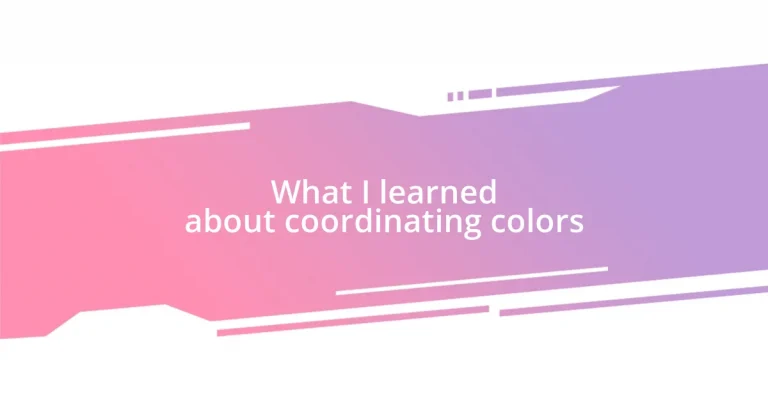Key takeaways:
- Understanding the color wheel, including primary, secondary, complementary, and warm/cool colors, is essential for creating effective color combinations that influence emotions and settings.
- Color harmony enhances visual design by evoking feelings, ensuring visual unity, maintaining engagement, focusing attention, and promoting timelessness in spaces.
- Common mistakes to avoid include relying on a single color, neglecting lighting effects, and failing to use color samples, which can lead to uninspired or unexpected outcomes in design.
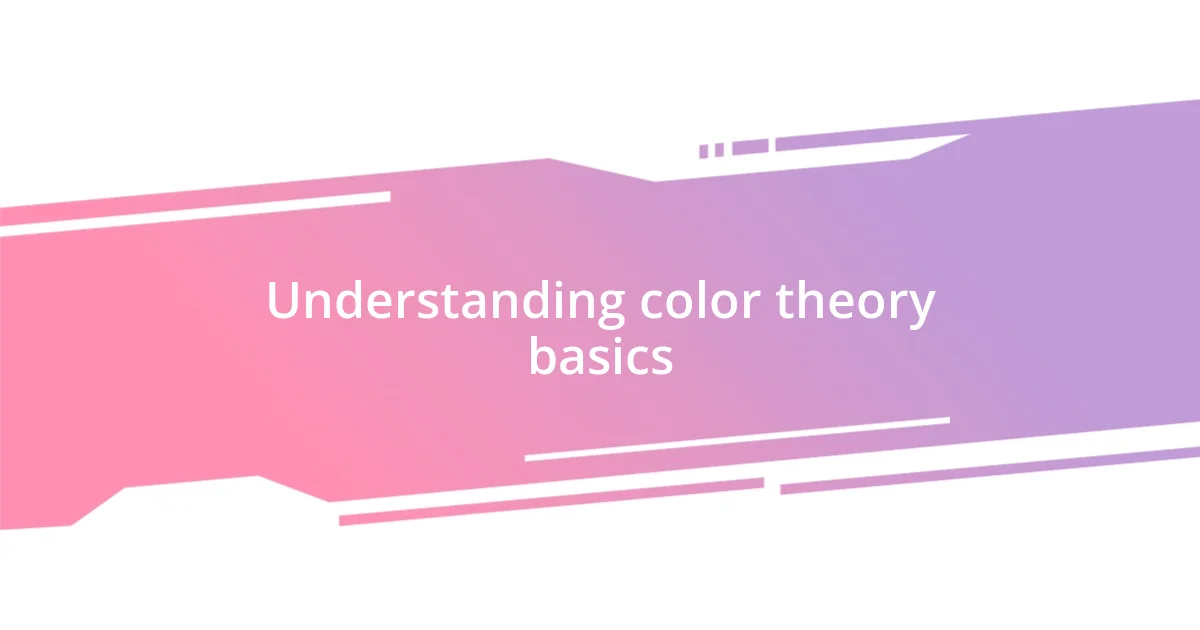
Understanding color theory basics
When diving into color theory, understanding the color wheel is crucial. It’s like finding the compass for your creative journey. I remember my first attempt at painting; I was overwhelmed by my choices until I realized that primary colors—red, blue, and yellow—could be mixed to form secondary colors like green and orange. This simple concept transformed how I viewed color combinations.
Complementary colors, which sit opposite each other on the wheel, can create striking contrasts. Have you ever seen a bright orange paired with deep blue? The energy is palpable! I noticed this during a friend’s wedding; her orange flowers against the blue sky added a vibrancy that captured the joy of the day beautifully. It made me appreciate how color relationships can enhance emotions and settings.
Additionally, warm colors (reds, yellows, oranges) tend to evoke feelings of warmth and excitement, while cool colors (blues, greens, purples) promote calm and relaxation. I often think about how this impacts my choices in home decor. A cozy living room with warm colors feels inviting, while my bedroom, painted in cool tones, helps me unwind at the end of the day. Isn’t it fascinating how colors can influence our moods and environments?
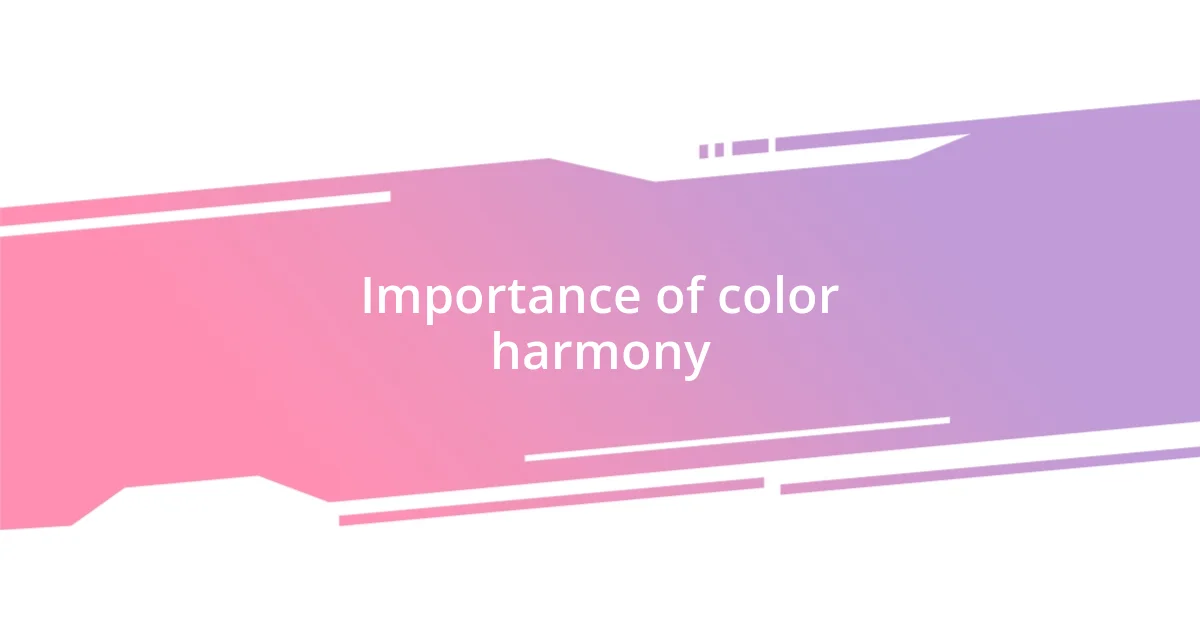
Importance of color harmony
Color harmony acts like a secret ingredient in visual design, creating a connection that resonates with our emotions. I recall a time when I decorated my home office. Initially, I had chosen mismatched colors that felt chaotic and unfocused. Once I embraced harmonious tones, everything clicked. The calming palette truly made a difference in my productivity. Balanced color schemes, such as analogous colors—those that sit next to each other on the color wheel—create soothing environments that invite creativity.
Here are some reasons why color harmony is essential:
- Emotional Impact: Harmonious colors evoke specific feelings, enhancing the overall mood of a space or design.
- Visual Unity: Colors that complement each other can unify disparate elements, making everything feel purposeful.
- Engagement: A well-coordinated color scheme draws attention and keeps the viewer engaged, much like a captivating story.
- Focus: By avoiding color clashes, harmony helps direct focus to the intended focal points, whether in art or design.
- Timelessness: Balanced color schemes often stand the test of time, making them a wise choice for enduring design.
Reflecting on my personal experiences, I’ve seen that when colors align harmoniously, it feels like the design is speaking a language of its own, creating spaces that are not just visually appealing but filled with a sense of peace and purpose.
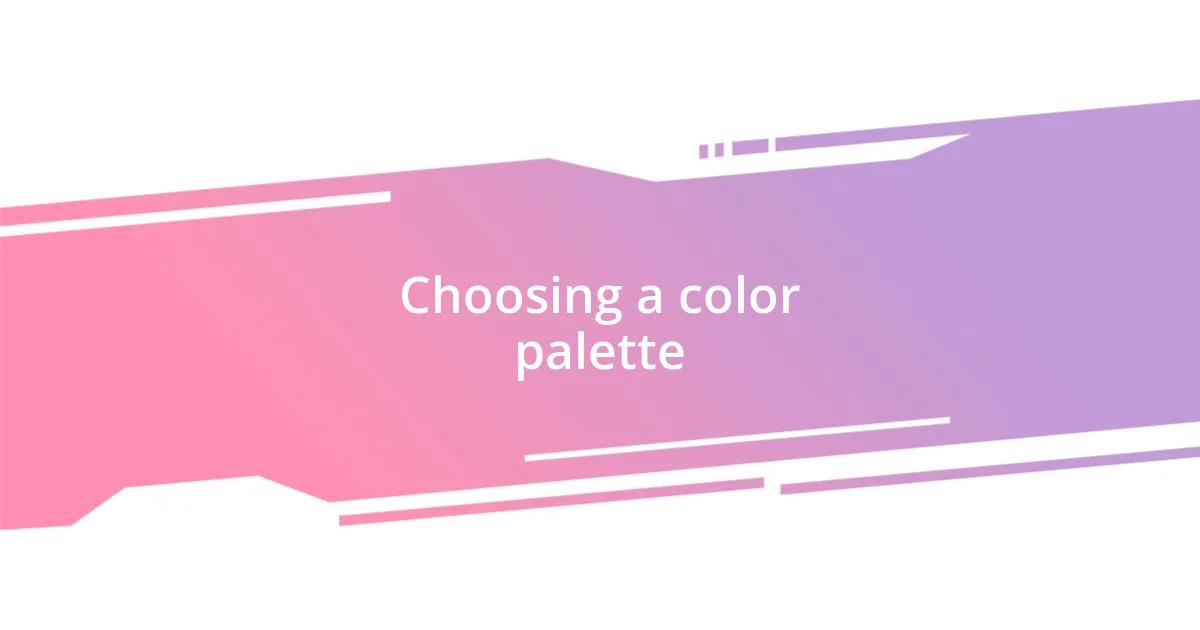
Choosing a color palette
Choosing the right color palette can feel like wandering through a candy store—overwhelming but exciting. I distinctly remember selecting colors for my first graphic design project. I spent hours experimenting with different shades, only to find that a cohesive palette of soft pastels gave my work a soothing quality. Sometimes, it’s not about using bold shades; subtlety can evoke a deeper emotional response.
When curating a palette, considering the psychology of colors is invaluable. For instance, I paired earthy greens with warm browns for a nature-themed project. The combination not only felt organic but also transported me to a serene forest retreat. I still recall the sense of calm I experienced while working on that design. I often ask myself—how does each color impact the overall feeling I want to convey?
One key aspect of color selection is flexibility. A successful palette might start with a primary color and branch out into complementary shades. During my latest home renovation, I originally planned a vibrant blue accent wall but eventually settled on a muted teal. This change not only harmonized with my furniture but also created a tranquil oasis. This reinforces my belief that sometimes stepping back and reevaluating options leads to a more successful outcome.
| Color Type | Emotional Response |
|---|---|
| Warm Colors | Excitement, Energy |
| Cool Colors | Calm, Relaxation |
| Analogous Colors | Harmony, Serenity |
| Complementary Colors | Contrast, Vibrancy |
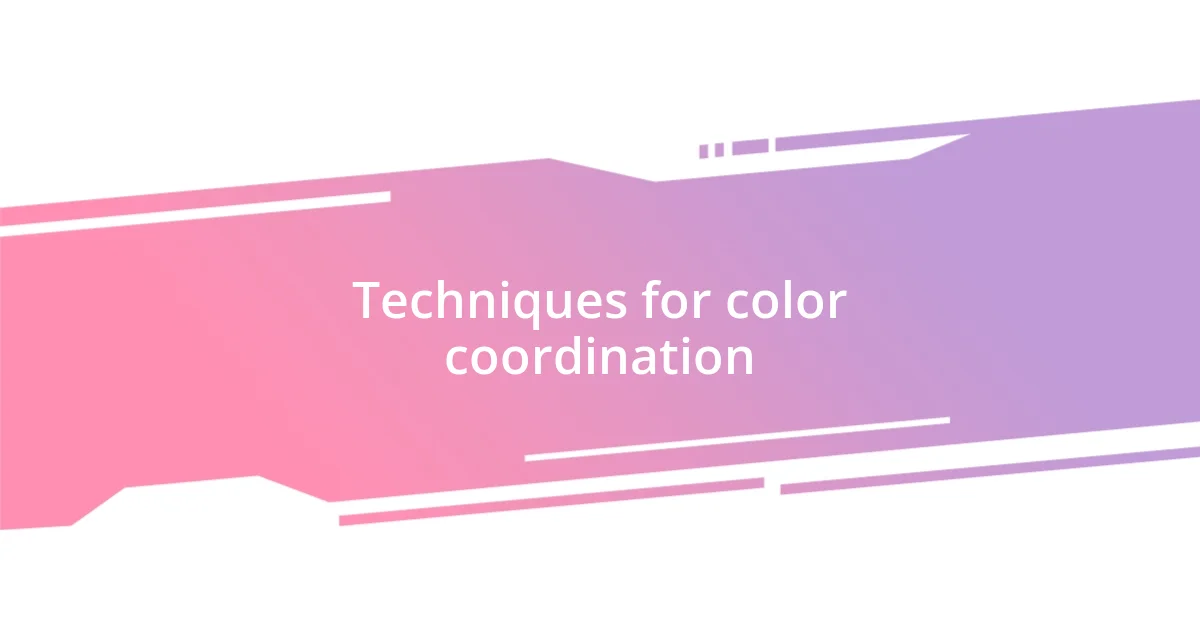
Techniques for color coordination
One technique I’ve found invaluable is the use of color swatches. When I decided to repaint my living room, I grabbed a handful of paint chips from the store. Laying them out next to each other, I could see how the shades interacted in real light. This simple act of visualization transformed my anxiety about color choices into excitement. Have you ever tried swatching colors at home? It can be a game-changer, revealing surprising harmonies and contrasts that you might not notice in isolation.
Another effective method involves exploring the 60-30-10 rule. Essentially, this guideline suggests that 60% of your space should be a dominant color, 30% a secondary color, and 10% an accent color. I remember applying this technique while redecorating my kitchen. I chose a soft, creamy white for the walls, paired it with navy blue cabinets, and accented with vivid yellow bar stools. The result was striking yet balanced, making my kitchen feel both vibrant and welcoming. This method really showcases how strategic distribution of colors can elevate a space.
Finally, embracing nature can provide wonderful inspiration. I often notice how seasonal changes influence color preferences. For my garden, I once used a palette of deep reds and bright oranges during autumn. This choice not only complemented the leaves but also evoked warmth and coziness as the weather turned cooler. It’s a reminder that sometimes, looking outside at the world around us can spark ideas that feel authentic and alive. How does nature’s palette inspire your creativity?
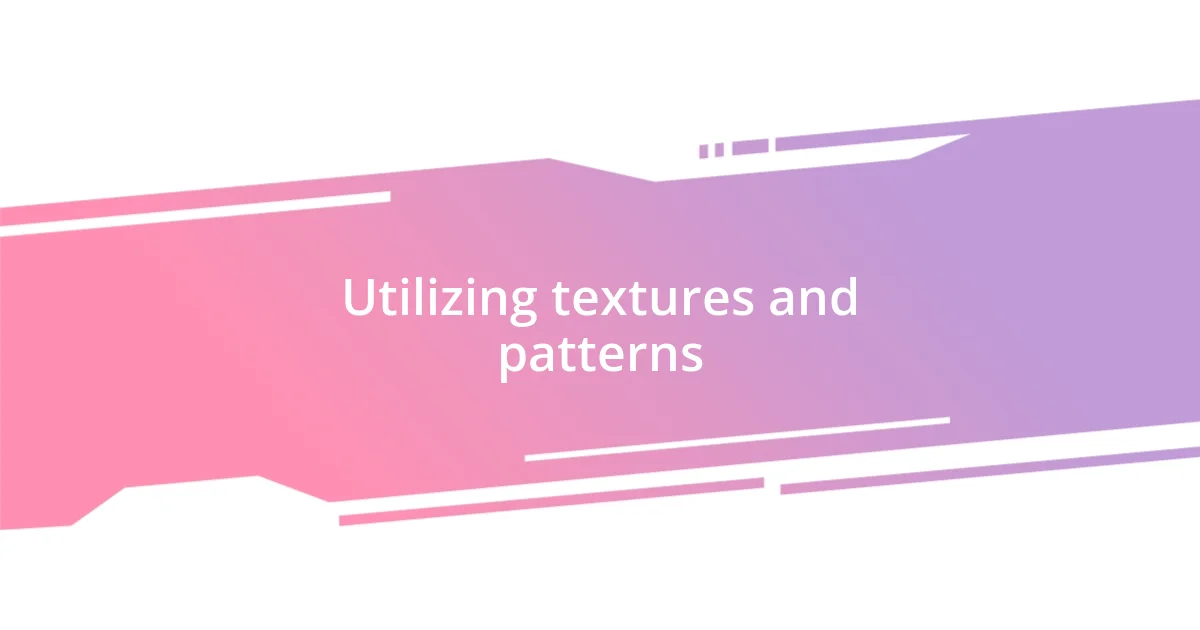
Utilizing textures and patterns
Utilizing textures and patterns can truly transform a space and add depth to any design. When I was decorating my bedroom, I decided to mix a soft, plush velvet with a crisp, geometric-patterned duvet cover. Initially, I was hesitant; would the textures clash? The outcome was stunning—a harmonious balance that added coziness without sacrificing style. Plus, it made the room feel more inviting. Have you ever tried combining textures in unexpected ways?
Patterns can also serve as wonderful focal points. I remember the day I stumbled across a bold floral wallpaper while browsing a local shop. At first, I worried it might overwhelm the space, but after envisioning it as an accent wall, I felt a surge of excitement. I paired it with subtle, solid colors for the rest of the room, creating a lively contrast that made the wallpaper shine without clashing. The room transformed into a joyful haven. How can a statement pattern elevate your designs?
To create a cohesive look, layering different textures is important. I often blend natural materials like wood and stone with softer fabrics to strike a balance that feels both organic and modern. For instance, I once combined a rustic wooden coffee table with a sleek metallic vase and a chunky knit throw. This mix not only looked visually appealing but also invited touch and interaction. The result was a space that felt alive and layered, just as I had imagined. In your experiences, how have textures impacted the stories your designs tell?
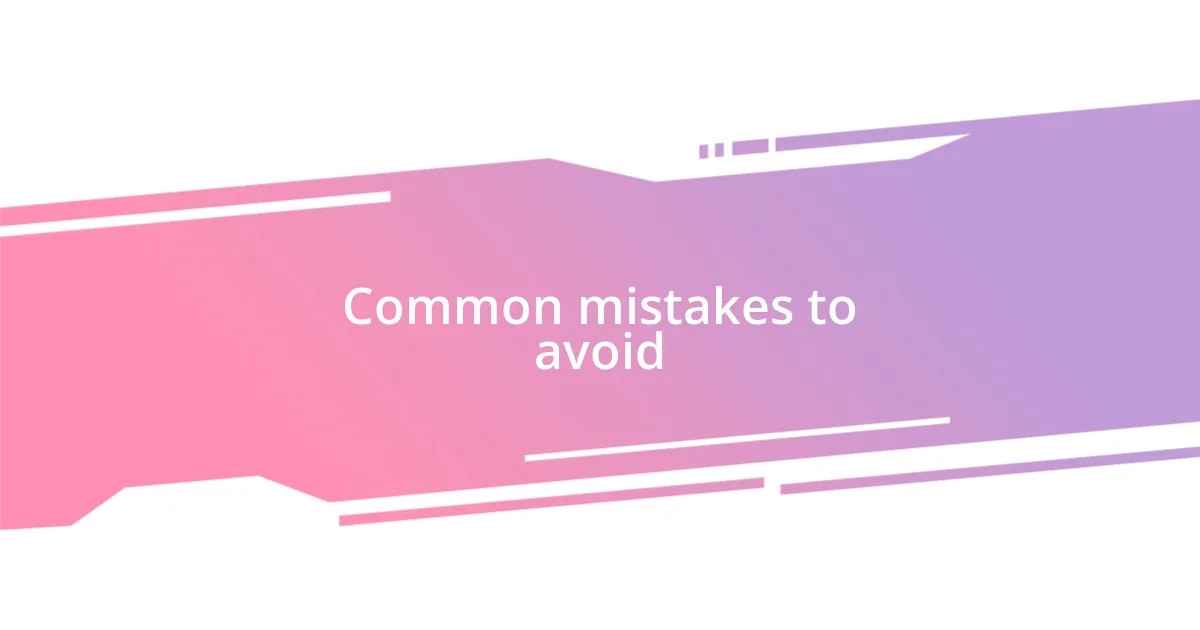
Common mistakes to avoid
One common mistake I often see is relying too heavily on a single color. I once decorated a friend’s home office in shades of beige thinking it would create a calming atmosphere. While it was a safe choice, after a few weeks, the space felt dull and uninspired. Instead, mixing in a pop of teal or mustard could have livened it up significantly. Have you ever noticed how a little color can breathe life into a space?
Another pitfall is failing to consider lighting when selecting colors. I learned this the hard way when I painted my bedroom a rich, dark blue. It looked stunning in the store, but under the artificial lights at home, it felt more cave-like than cozy. I truly regret not testing it out first with different lighting options. Are you checking your colors in various lights before committing?
Finally, avoiding the use of samples can lead to regret. I remember picking a bright coral for my hallway without swatching it on the actual wall. In theory, it sounded perfect, but in reality, it clashed with my art and felt overpowering. Taking that extra step to see how colors work in your own space, rather than just imagining them, is essential. How do you test your color choices before painting?












